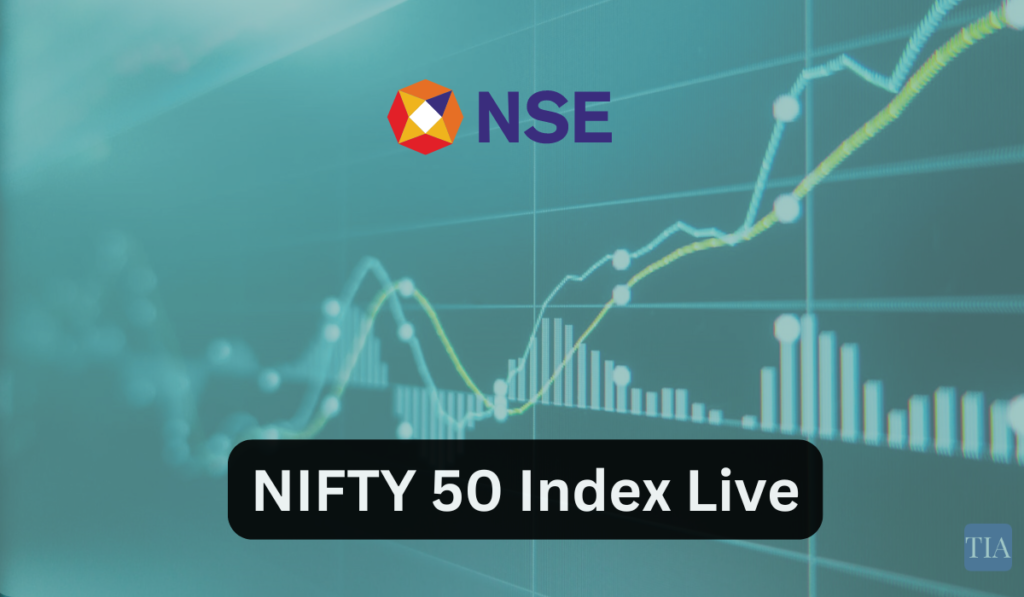NIFTY 50 Index Price Live Chart
NIFTY Future Index Price Live Analysis
Table of Contents

About NIFTY 50
NIFTY 50, popularly known as NIFTY, is actually an Indian stock market index of the NSE (National Stock Exchange). It indicates the average weighted price of the top 50 well-established and large-cap companies listed on the NSE (National Stock Exchange). It plays an important role in measuring the performance level of the Indian stock market and depicts the condition of various large sectors of the economy. This index serves as an average of the price change of the stocks that it includes, thus serving as a crucial reference for investors or analysts.
What’s NIFTY 100 & NIFTY 500?
In addition to the NIFTY 50, the NSE offers broader indices to reflect more comprehensive market trends:
• NIFTY 100: This index includes the top 100 companies from the NIFTY FIFTY and additional prominent stocks. While it offers a broader perspective in terms of the market, it differs from NIFTY50 by including a larger segment of the best-performing shares.
• NIFTY 500: This is a broader index that comprises of 500 large firms traded on the NSE. It captures the general market performance and may contain both large cap, mid ca, small cap stocks. The NIFTY 500 offers a wider and more diverse perspective of markets covering sectors and companies of different market capitalization.
How is NIFTY50 calculated?
The NIFTY indices are based on float adjusted market capitalization of the stocks. This method involves:
1. Selecting Stocks: Equities are chosen considering factors such as liquidity and market value. The companies are selected from among the best performers in the given market.
2. Calculating Free-Float Market Capitalization: This means the stock’s price and the number of shares in the market other than those float by promoters or strategic investors.
3. Index Calculation Formula: NIFTY index value itself is determined by the total free float market capitalization of its index stocks divided by the base market capitalisation and then multiplying the figure with the base index value. This formula helps make the index proportional to the market value of the stocks that make up the index.
How to Trade in NIFTY 50?
Trading in NIFTY 50 can be done through several financial instruments:Trading in NIFTY 50 can be done through several financial instruments:
1. NIFTY Futures: Futures contracts are the legal agreements to purchase or sell of the NIFTY 50 index at a specific price in the future. This enables traders to make prediction on exiting or future movement of the index.
2. NIFTY Options: Futures are agreements that guarantee the buyer the right to purchase or the seller the right to sell the NIFTY FIFTY at a particular price during a specified period. Options bring flexibility and bargaining power in the trading business.
3. Exchange-Traded Funds (ETFs): NIFTY ETFs refer to the exchange traded funds that invest in the NIFTY 50 index. They can be traded in the stock market like any other ordinary shares.
4. Index Funds: These are mutual fund schemes whose investment objective is to track the NIFTY 50 index. They provide a diversified investment strategy by adopting a portfolio that replicates the index.
How to Analyze NIFTY 50 Chart?
Analyzing the NIFTY50 chart involves various techniques and indicators:
1. Technical Analysis: This includes analyzing past price and charts to forecast the future prices of the stock. Some popular patterns are trend lines, support and resistance levels and some of the candlestick patterns.
2. Moving Averages: Exponential Moving Average smoothes price data making it easy to identify trends in the market. Some of the most commonly used moving averages include the fifteen, fifty, and two hundred day moving averages. Cross of these averages may indicate bullish or bearish stance.
3. Relative Strength Index (RSI): RSI is a momentum indicator that calculates the velocity and magnitude of the changes in prices. It is a percentage scale ranging from 0 to 100 and shows when the asset is overbought or oversold.
4. Bollinger Bands: These are volatility bands and are made up of the middle band which is the SMA and two outer bands that are standard deviations from SMA. They assist to determine the level of market volatility and possible trend reversion.
5. Volume Analysis: Volume analysis can be used to substantiate trends and to predict a reversal in a particular stock. High volumes normally act as a precursor to either a steep rise in prices or a steep drop in prices of a product.
Conclusion
To sum up, the NIFTY 50 plays a significant role in measuring the performance of the largest companies in the Indian market. Knowing the formula and components that make up the ratio gives investors more insight into it. NIFTY 100 and Nifty 500 give a wider view and several avenues to trade and invest involve trading platforms and tools. Through the mastery of charts and trading strategies, people can easily maneuver the volatile terrain of the Indian stock exchange.